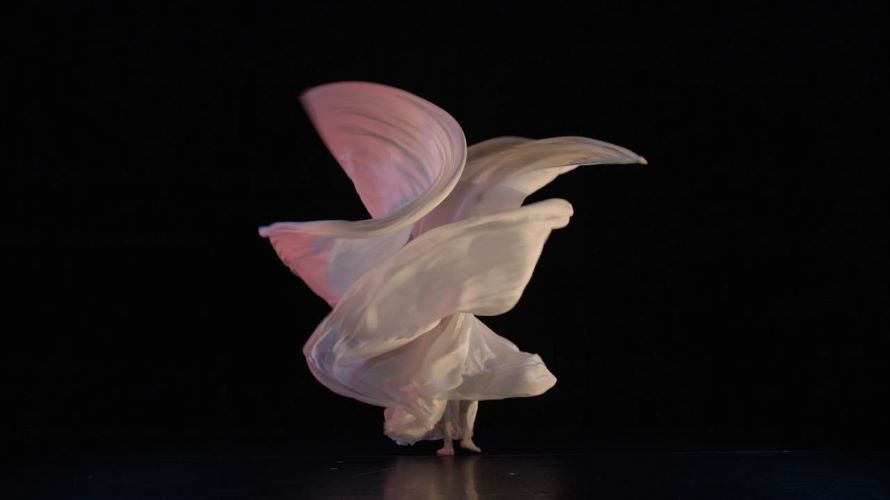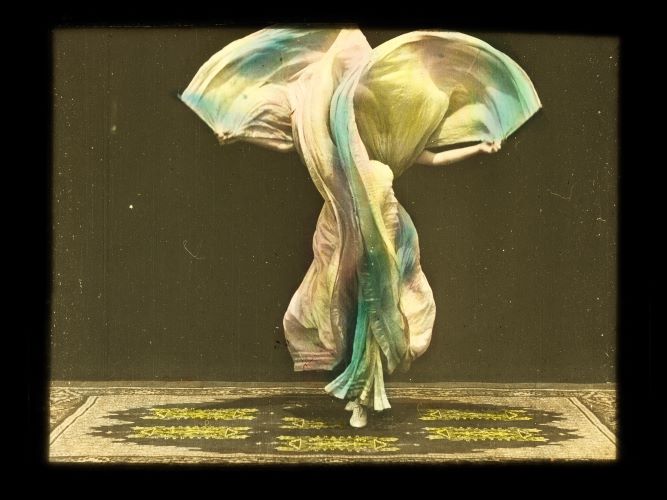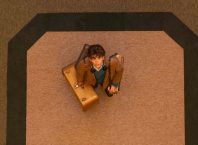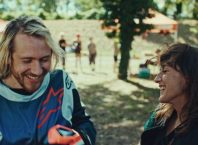
Loïe Fuller (1862 – 1928) was a dancer and innovator, a self-described “Western Gal” from Illinois who took Paris by storm and ignited the imaginations of artists, poets, and scientists. James McNeill Whistler drew her as she danced, and Stéphan Mallarmé wrote about her. A trailblazer of modern dance, Fuller made a lasting impact not only on choreography and movement, but on the artistic and technical aspects of lighting and set design. The documentary film Obsessed with Light, directed by Sabine Krayenbühl and Zeva Oelbaum, illuminates Fuller’s life and contribution, bringing her vividly to life in her own words, as voiced by Cherry Jones. An abundance of archival footage is complemented by live interviews with contemporary artists, designers, and dancers, whose work relates to Fuller’s, creating a conversation between past and present in a visually exhilarating film.
Fuller began performing as a young child, although not as a dancer. She did not have the typical tall, lithe figure expected of a ballerina. Glass designer Clara Driscoll (1861 – 1944) is quoted as calling her a “fat, dumpy, short-necked woman.” Yet, as she developed the Serpentine Dance which established her fame, a dance which required strength as well as agility, Fuller reflected, “If I hadn’t been stocky like my father I could never have done it.” Fuller held sticks in her arms, extending her reach. Covered by yards of silk, she used the sticks to manipulate the fabric, making endlessly shifting shapes. The factual description does not begin to convey the effect of Fuller’s dance, and the archival footage is one of the treasures of this film.

Fuller possessed a lively curiosity and fierce determination. Intrigued by the properties of silk as it moved and reflected light, she created a dance of swirling fabric and shifting forms. Dance at that time was still very much based on narrative, yet Fuller was creating something whose essence was inherent in the form and movement, as she said, “I wasn’t dancing to stand for something.” In Fuller’s reflections on her life and career, her strength, honesty, drive, and endless delight in discovery make her a fascinating character to follow.
Yet Krayenbühl and Oelbaum take the film beyond biography to demonstrate the extent to which Fuller’s work has permeated contemporary artistic consciousness. Interviews with theatre director Robert Wilson; Dior Creative Director Maria Grazia Chiuri; designer Iris van Herpen; lighting designer Jennifer Tipton; choreographers Moses Pendleton (MOMIX), Ola Maciejewska, Bill T Jones, Trajal Harrell, and Maite Marcos; artists William Kentridge, Elín Hansdóttir, and Marcel Dzama; Drift collective founders Lonneke Gordijn and Ralph Nauta; puppeteer Basil Twist, and theatre producer Jordan Roth. Each offers a different perspective on Fuller’s work, from their individual fields, all enhancing one’s appreciation of Fuller, and offering insight into the arts with excerpts from their works. As when Tipton comments, “light can also have a second narrative, a secret one,” inviting the viewer to look more intently at the way lighting works in dance, theatre, and film. Interspersed throughout the film is the creation and rehearsal of a new dance, described by its choreographer Jody Sperling as a “conversation with Loïe Fuller.” Beyond the beauty of Time Lapse Dance, the scenes with Sperling and her dancers evoke the sense of process, the experiments, difficulties, and discoveries that accompany the creation of a new work.
Fuller was a daring artist, following the path of her inspiration and curiosity, taking personal and financial risks, and never giving up. She created a new form of dance and was one of the first dancers to try to protect her work with a legal copywrite. She was as courageous in her personal life as in her work, living openly with Gabrielle Bloch (known as Gab Sorère). Despite tributes from such cultural phenomena as Taylor Swift and Red Hot Chilli Peppers, Fuller and the significance of her work have faded with time, the film brings her legacy to a wider audience.
Obsessed with Light will be shown at Docaviv 2024, screening times and additional information are available on the Docaviv website. Obsessed with Light will be shown on YESdocu and STING on June 9, 2024.
Obsessed with Light
United States/Germany/France/2023/90 min/English, French, Icelandic, Italian, and Spanish with English subtitles
Directed and Produced by Sabine Krayenbühl and Zeva Oelbaum; Editing: Sabine Krayenbühl; Cinematography: Bob Richman, Claudia Raschke; Sound Design: Eddie O’Conor; Music: Paul Cantelon





